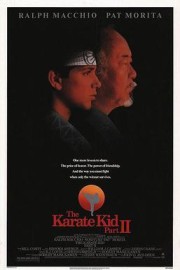The Karate Kid Part II
**This piece was written during the 2023 WGA and SAG-AFTRA strikes. Without the labor of the writers and actors currently on strike, the movies being covered here wouldn’t exist.
Apart from probably one of the best movie power ballads of the 1980s in Peter Cetera’s “Glory of Love,” I don’t know if I would have considered “The Karate Kid Part II” in higher regard over the original at any time. I do think I probably watched “Part II” more growing up, but it wasn’t necessarily a conscious decision. After a few rewatches in the past few years, however- and a couple this year- I would say that I might love what John G. Avildsen and writer Robert Mark Kamen did in “Part II” considerably more than what they manage in the original, which is basically a “Rocky” clone.
The thematic weight throughout all of the films with Ralph Macchio’s Daniel and Pat Morita’s Mr. Miyagi (I cannot speak on “The Next Karate Kid”) is an examination of toxic masculinity, decades before the term took hold, and how students are only as good as the values their teachers impart. That has been a fundamental part in “Cobra Kai,” as well, on top of how the series has managed to make every one of the three films about Daniel and Miyagi richer in how they bring back different characters. What separates “Part II” from the rest is what I love most about it- how it’s less about Daniel but about Miyagi, and that is something we don’t really see in underdog sports movies, even sequels- most films are focused so intensely on the underdog that the mentor is left in the background, as the main one in the hero’s corner cheering him on. “Part II” is that way in the end, but we accept it because of how richly it expands on Miyagi’s character.
In “The Karate Kid” (1984 version), Miyagi is a mysterious, lovable outcast who has some important lessons for Daniel, who is the quintessential “just moved here and am being bullied” ’80s hero. We learn some about him- he’s a WWII veteran, left Japan because of a woman, and has some sadness in his life. “Part II” begins after the tournament, and Daniel and Miyagi are leaving when they see Kreese (Martin Kove) bullying Johnny (William Zabka) for coming in second. Miyagi intervenes, and right away we see the character in a different light; he’s already shown himself as a strong fighter, but here he really seems like he could kill Kreese. His final blow, however, is more of a humiliation; for a man like Kreese, death is mercy- his failure and toxic need for vengeance is the greater punishment. As Miyagi returns to his village of Okinawa in Japan, with Daniel in tow, when he learns his father is dying, that is going to resonate throughout the film.
Sato (Danny Kamekona) was Miyagi’s best friend, and learned karate from Miyagi’s father, until he was spurned by the woman Miyagi loved, and challenged Miyagi to a fight to the death. That is when Miyagi left Okinawa for the States. When Miyagi and Daniel arrive, it is only for Miyagi’s father, but of course Sato wants what he is owed. Assisting him is his nephew, Chozen (Yuji Okumoto), who transfers the hate his uncle feels to Daniel. Right now, this is very much of a piece with the ethos of the original “Karate Kid,” but rather than teaching Daniel to fight, Miyagi now choses to teach pacifism. Vengeance is a disease to someone like Sato, and while not indulging it could lead to collateral damage, Miyagi’s approach to Sato is one not of his own self interest, but for those he cares about- it’s only when they are threatened that he is inspired to act, and give Sato what he wants. Morita may have been Oscar-nominated for the original, but I would argue he is better here; what made him lovable is still there, but this time he has an emotional reunion with the love of his life (Nobu McCarthy), and a selflessness to what he wants to impart on Daniel that takes hold, not just in how he connects with Kumiko (Tamlyn Tomita), but in how he wants to help those around him in the village. If the original film was about helping Daniel believe in himself, “Part II” is showing him how to use that towards helping others. And Macchio is a good student.
This is not structured in nearly the same way as the first film, but everything still builds to this film’s thrilling climax. The renewed love of Miyagi and Yukie. The young romance between Daniel and Kumiko. The way Miyagi manages to wear Sato’s hate down, and how Sato’s hate manifests in Chozen, leading to some choices that are melodramatic, but also absolutely logical for his character. I love the scene where Daniel’s mouth gets him in trouble where he’s forced to break six pieces of ice. I love the storm and how it changes fates forever. And then the end, which starts with a joyful return to tradition before turning into a moment of solidarity when Daniel’s courage is tested in a fight to the death. I love the soundtrack, from the songs to Bill Conti’s score. I love Avildsen’s direction. And I just love what this movie represents, a sequel wanting to do more than just rest on its predecessor’s laurels. It comes out successful in the end.










